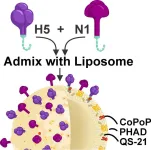(Press-News.org) CAMBRIDGE, MA -- Cleft lip and cleft palate are among the most common birth defects, occurring in about one in 1,050 births in the United States. These defects, which appear when the tissues that form the lip or the roof of the mouth do not join completely, are believed to be caused by a mix of genetic and environmental factors.
In a new study, MIT biologists have discovered how a genetic variant often found in people with these facial malformations leads to the development of cleft lip and cleft palate.
Their findings suggest that the variant diminishes cells’ supply of transfer RNA, a molecule that is critical for assembling proteins. When this happens, embryonic face cells are unable to fuse to form the lip and roof of the mouth.
“Until now, no one had made the connection that we made. This particular gene was known to be part of the complex involved in the splicing of transfer RNA, but it wasn’t clear that it played such a crucial role for this process and for facial development. Without the gene, known as DDX1, certain transfer RNA can no longer bring amino acids to the ribosome to make new proteins. If the cells can’t process these tRNAs properly, then the ribosomes can’t make protein anymore,” says Michaela Bartusel, an MIT research scientist and the lead author of the study.
Eliezer Calo, an associate professor of biology at MIT, is the senior author of the paper, which appears today in the American Journal of Human Genetics.
Genetic variants
Cleft lip and cleft palate, also known as orofacial clefts, can be caused by genetic mutations, but in many cases, there is no known genetic cause.
“The mechanism for the development of these orofacial clefts is unclear, mostly because they are known to be impacted by both genetic and environmental factors,” Calo says. “Trying to pinpoint what might be affected has been very challenging in this context.”
To discover genetic factors that influence a particular disease, scientists often perform genome-wide association studies (GWAS), which can reveal variants that are found more often in people who have a particular disease than in people who don’t.
For orofacial clefts, some of the genetic variants that have regularly turned up in GWAS appeared to be in a region of DNA that doesn’t code for proteins. In this study, the MIT team set out to figure out how variants in this region might influence the development of facial malformations.
Their studies revealed that these variants are located in an enhancer region called e2p24.2. Enhancers are segments of DNA that interact with protein-coding genes, helping to activate them by binding to transcription factors that turn on gene expression.
The researchers found that this region is in close proximity to three genes, suggesting that it may control the expression of those genes. One of those genes had already been ruled out as contributing to facial malformations, and another had already been shown to have a connection. In this study, the researchers focused on the third gene, which is known as DDX1.
DDX1, it turned out, is necessary for splicing transfer RNA (tRNA) molecules, which play a critical role in protein synthesis. Each transfer RNA molecule transports a specific amino acid to the ribosome — a cell structure that strings amino acids together to form proteins, based on the instructions carried by messenger RNA.
While there are about 400 different tRNAs found in the human genome, only a fraction of those tRNAs require splicing, and those are the tRNAs most affected by the loss of DDX1. These tRNAs transport four different amino acids, and the researchers hypothesize that these four amino acids may be particularly abundant in proteins that embryonic cells that form the face need to develop properly.
When the ribosomes need one of those four amino acids, but none of them are available, the ribosome can stall, and the protein doesn’t get made.
The researchers are now exploring which proteins might be most affected by the loss of those amino acids. They also plan to investigate what happens inside cells when the ribosomes stall, in hopes of identifying a stress signal that could potentially be blocked and help cells survive.
Malfunctioning tRNA
While this is the first study to link tRNA to craniofacial malformations, previous studies have shown that mutations that impair ribosome formation can also lead to similar defects. Studies have also shown that disruptions of tRNA synthesis — caused by mutations in the enzymes that attach amino acids to tRNA, or in proteins involved in an earlier step in tRNA splicing — can lead to neurodevelopmental disorders.
“Defects in other components of the tRNA pathway have been shown to be associated with neurodevelopmental disease,” Calo says. “One interesting parallel between these two is that the cells that form the face are coming from the same place as the cells that form the neurons, so it seems that these particular cells are very susceptible to tRNA defects.”
The researchers now hope to explore whether environmental factors linked to orofacial birth defects also influence tRNA function. Some of their preliminary work has found that oxidative stress — a buildup of harmful free radicals — can lead to fragmentation of tRNA molecules. Oxidative stress can occur in embryonic cells upon exposure to ethanol, as in fetal alcohol syndrome, or if the mother develops gestational diabetes.
“I think it is worth looking for mutations that might be causing this on the genetic side of things, but then also in the future, we would expand this into which environmental factors have the same effects on tRNA function, and then see which precautions might be able to prevent any effects on tRNAs,” Bartusel says.
###
The research was funded by the National Science Foundation Graduate Research Program, the National Cancer Institute, the National Institute of General Medical Sciences, and the Pew Charitable Trusts.
END
New study reveals how cleft lip and cleft palate can arise
MIT biologists have found that defects in some transfer RNA molecules can lead to the formation of these common conditions
2025-04-17
ELSE PRESS RELEASES FROM THIS DATE:
Scientists hack cell entry to supercharge cancer drugs
2025-04-17
A new discovery could pave the way for more effective cancer treatment by helping certain drugs work better inside the body.
Scientists at Duke University School of Medicine, University of Texas Health Science Center at San Antonio, and University of Arkansas have found a way to improve the uptake of a promising class of cancer-fighting drugs called PROTACs, which have struggled to enter cells due to their large size.
The new method works by taking advantage of a protein called CD36 that helps pull substances into cells. By designing drugs to use this CD36 pathway, researchers delivered 7.7 to 22.3 times more of the drug inside cancer cells, making ...
Study: Experimental bird flu vaccine excels in animal models
2025-04-17
BUFFALO, N.Y. — A vaccine under development at the University at Buffalo has demonstrated complete protection in mice against a deadly variant of the virus that causes bird flu.
The work, detailed in a study published today (April 17) in the journal Cell Biomaterials, focuses on the H5N1 variant known as 2.3.4.4b, which has caused widespread outbreaks in wild birds and poultry, in addition to infecting dairy cattle, domesticated cats, sea lions and other mammals.
In the study, scientists describe a process they’ve developed for creating doses with precise ...
Real-world study finds hydroxyurea effective long-term in children living with sickle cell disease
2025-04-17
(WASHINGTON, April 17, 2024) — Hydroxyurea remains effective long-term in reducing emergency department visits and hospital days for children living with sickle cell disease (SCD), according to new research published in Blood Advances.
“This is one of the first large, real-world, long-term studies to assess the efficacy of hydroxyurea outside of a controlled setting,” said study author Paul George, MD, a pediatric hematology/oncology fellow and PhD candidate at Emory University School of Medicine and Aflac Cancer and Blood Disorders Center at Children’s ...
FAU designated a National Center of Academic Excellence in Cyber Research
2025-04-17
Florida Atlantic University has been recognized as a National Center of Academic Excellence in Cyber Research (CAE-R) by the National Security Agency (NSA) and its partners in the National Centers of Academic Excellence in Cybersecurity (NCAE-C). This prestigious designation, awarded through the academic year 2030, affirms the university’s leadership and innovation in the field of cybersecurity research at the doctoral level.
This recognition places FAU among an elite group of institutions nationwide that have demonstrated a sustained commitment to cutting-edge research in cyber defense and security. The CAE-R designation is awarded to universities whose programs meet rigorous ...
European potato genome decoded: Small gene pool with large differences
2025-04-17
A research team has decoded the genome of historic potato cultivars and used this resource to develop an efficient method for analysis of hundreds of additional potato genomes.
Potatoes are a staple food for over 1.3 billion people. But despite their importance for global food security, breeding successes have been modest. Some of the most popular potato cultivars were bred many decades ago. The reason for this limited success is the complex genome of the potato: there are four copies of the genome in each cell instead of just two. ...
Nontraditional risk factors shed light on unexplained strokes in adults younger than 50
2025-04-17
Research Highlights:
Among adults ages 18-49 (median age of 41 years) who were born with a hole in the upper chambers of their heart known as patent foramen ovale (PFO), strokes of unknown cause were more strongly associated with nontraditional risk factors, such as migraines, liver disease or cancer, rather than more typical factors such as high blood pressure.
Migraine with aura was the top factor linked to strokes of unknown causes, also called cryptogenic strokes, especially among women.
Embargoed ...
Extreme drought contributed to barbarian invasion of late Roman Britain, tree-ring study reveals
2025-04-17
Three consecutive years of drought contributed to the ‘Barbarian Conspiracy’, a pivotal moment in the history of Roman Britain, a new Cambridge-led study reveals. Researchers argue that Picts, Scotti and Saxons took advantage of famine and societal breakdown caused by an extreme period of drought to inflict crushing blows on weakened Roman defences in 367 CE. While Rome eventually restored order, some historians argue that the province never fully recovered.
The ‘Barbarian Conspiracy’ of 367 CE was one of the most severe threats to Rome’s hold on Britain since the Boudiccan revolt three centuries earlier. Contemporary sources indicate that components ...
Antibiotic-resistant E. albertii on the rise in Bangladeshi chicken shops
2025-04-17
If you have ever chickened out of eating chicken, your unease may not have been unreasonable.
Osaka Metropolitan University researchers have detected alarming rates of Escherichia albertii, an emerging foodborne pathogen, in retail chicken meat in Bangladesh. Their findings show extensive contamination and significant antimicrobial resistance, underscoring the potential risks to public health.
E. albertii is a less known but probably not less dangerous relative of E. coli. First described in Bangladesh in 2003, this bacterium ...
Veterinary: UK dog owners prefer crossbreeds and imports to domestic pedigree breeds
2025-04-17
The UK pedigree dog population shrank by a yearly decline of 0.9% between 1990 and 2021, according to research published in Companion Animal Genetics and Health. The study highlights a rise in the populations of crossbreeds and imported pedigree dogs since 1990, but finds that only 13.7% of registered domestic pedigree dogs were used for breeding between 2005 and 2015.
There are more than 400 breeds of dogs globally, characterised by different appearances and behaviours. While the overall population of pet dogs in the UK ...
Study links climate change to rising arsenic levels in paddy rice, increasing health risks
2025-04-16
Climate change may significantly impact arsenic levels in paddy rice, a staple food for millions across Asia, reveals a new study from Columbia University’s Mailman School of Public Health. The research shows that increased temperatures above 2°C, coupled with rising carbon dioxide (CO2) levels, lead to higher concentrations of inorganic arsenic in rice, potentially raising lifetime health risks for populations in Asia by 2050. Until now, the combined effects of rising CO2 and temperatures on arsenic accumulation in rice have not been studied in detail. The research done ...
LAST 30 PRESS RELEASES:
New study overturns long-held model of how plants coordinate immune responses.
New AI model predicts disease risk while you sleep
Scientists discover molecular ‘reshuffle’ and crack an 80-year-old conundrum
How stressors during pregnancy impact the developing fetal brain
Electrons lag behind the nucleus
From fungi to brain cells: one scientist's winding path reveals how epigenomics shapes neural destiny
Schizophrenia and osteoporosis share 195 genetic loci, highlighting unexpected biological bridges between brain and bone
Schizophrenia-linked genetic variant renders key brain receptor completely unresponsive to both natural and therapeutic compounds
Innovative review reveals overlooked complexity in cellular energy sensor's dual roles in Alzheimer's disease
Autism research reframed: Why heterogeneity is the data, not the noise
Brazil's genetic treasure trove: supercentenarians reveal secrets of extreme human longevity
The (metabolic) cost of life
CFRI special issue call for papers: New Frontiers in Sustainable Finance
HKU Engineering scholar demonstrates the smallest all-printed infrared photodetectors to date
Precision empowerment for brain "eavesdropping": CAS team develops triple-electrode integrated functional electrode for simultaneous monitoring of neural signals and chemical transmitters during sleep
Single-capillary endothelial dysfunction resolved by optoacoustic mesoscopy
HKU three research projects named among ‘Top 10 Innovation & Technology News in Hong Kong 2025’ showcasing excellence in research and technology transfer
NLRSeek: A reannotation-based pipeline for mining missing NLR genes in sequenced genomes
A strand and whole genome duplication–aware collinear gene identification tool
Light storage in light cages: A revolutionary approach to on-chip quantum memories
Point spread function decoupling in computational fluorescence microscopy
BacPhase: Long-insert paired-end sequencing for bin marker construction and genome phasing
GmWOX1 regulates the mediolateral polarity of compound leaves in soybean
ChargeFabrica: An open-source simulation tool that aims to accelerate search for high performance perovskite solar cells
High levels of ADAR overexpression induce abundant and stochastic off-target RNA editing in rice protoplasts
On-demand upgraded recycling of polyethylene and construction of sustainable multifunctional materials based on the "LEGO" strategy
New "Stomata in-sight" system allows scientists to watch plants breathe in real-time
Anorexia nervosa may result in long-term skeletal muscle impairment
Narrative-based performance reviews deemed fairest by employees
New insights reveal how advanced oxidation can tackle emerging water pollutants
[Press-News.org] New study reveals how cleft lip and cleft palate can ariseMIT biologists have found that defects in some transfer RNA molecules can lead to the formation of these common conditions



